
November 14
Unfortunately I have some sad news to share with everyone who follows the Mayo Clinic falcons in Rochester.
As humans, we get emotionally invested with the animals we study, and although I intellectually know that mortality is high for peregrines during their first year of life, it's always hard to get a report or sighting notifying us that a bird has passed away. Recently, a member of the Rochester Mayo staff reported that the remains of one of the 2022 peregrines had been found. Comet was found on an upper level of the Plummer Building, but had passed too long ago to be able to determine the cause of death.
By banding birds, we learn an amazing amount of information about their lives, such as longevity, migration patterns, nesting success (or failures), dispersal distances from their natal (hatch) territory to a future nesting territory, and individual behavior patterns to name just a few. And although this news is difficult to receive, it is still important information to know about peregrines in the Upper Midwest, MInnesota, and specifically, survivability of Mayo Clinic's falcons.
Today's photo is of Comet from her banding event on May 25, 2022, at 20 days of age.
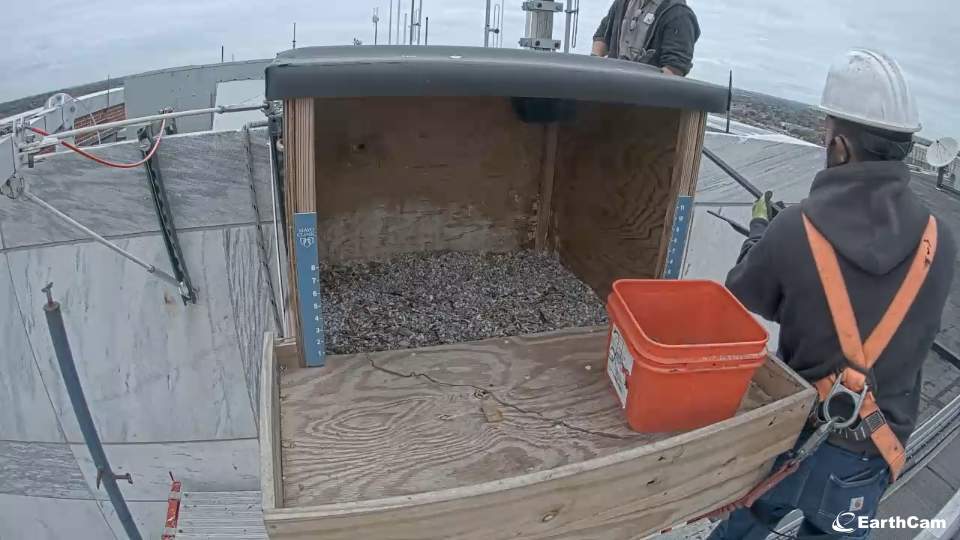
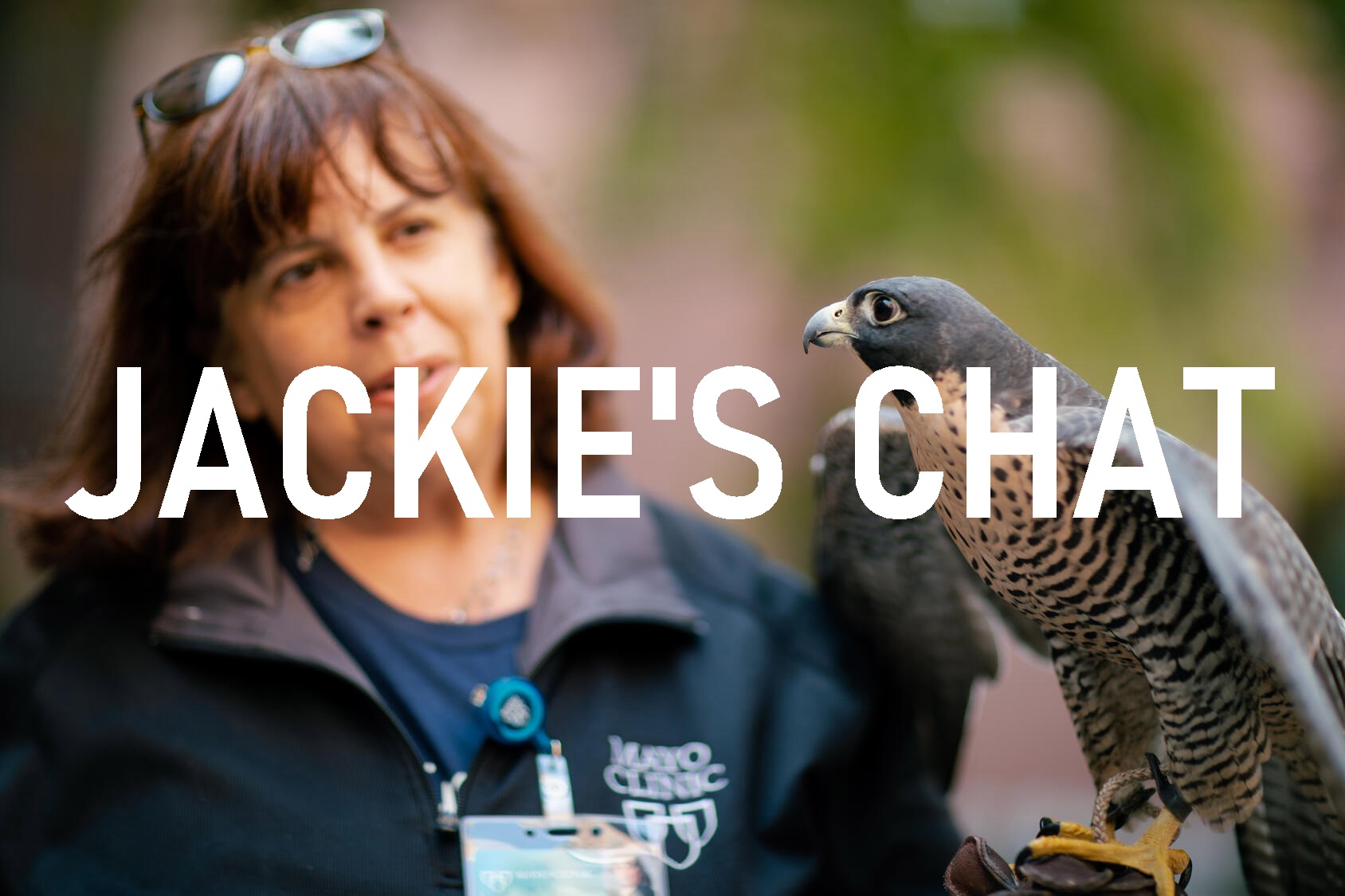
September 21
Axel Gumbel from Mayo Clinic Communications catches up with Jackie Fallon to learn the latest on Mayo's peregrine falcons and what to expect this fall.

Where are the Fledglings?
August 2
Many of you are wondering about the 2023 fledglings of Rochester's Mayo Clinic and if they are still in town. Project biologists have spent at least five to six hours at the downtown campus on two separate days this past week, hoping to find them. They have looked at all of the traditional peregrine perching spots, asking numerous Mayo Clinic employees that often send me sightings throughout the year, but no one could say for certain that they had seen Genesis, Aero, Piper, or Horus since the middle of July.
Again, this is to be expected since they have been out of the nest box for two months now, fine-tuning their flight and hunting skills. Eventually, the fledglings leave their natal territory and start a new stage of their lives by exploring the state and living up to their name, "the wanderer." It is always possible that they are still in Rochester, but at this stage of their life, it makes more sense that they have left the area than to say they are still in town.
Although the biologists didn’t find any fledglings, they were happy to find Hattie and Orton at their traditional downtown perching areas, watching them chase pigeons, preen, or even just take a nap. Mayo Clinic has played a significant role in this restoration effort, and hopefully, many of you may have the opportunity to view the falcons for yourself when in Rochester. Adults or fledglings, they are all exciting to see.
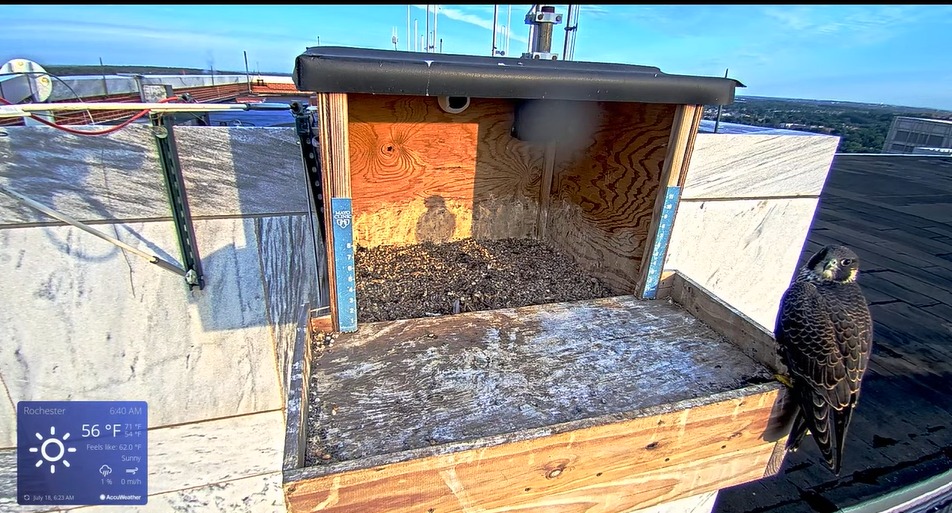
Tuesday Visitor
July 18
Look who showed up this morning! One of the fledglings made a quick visit to the nest box in downtown Rochester, although I wasn't able to read the color band information. The visits will continue to be very infrequent, but you never know when a visitor may appear, so the camera will remain on through early August.
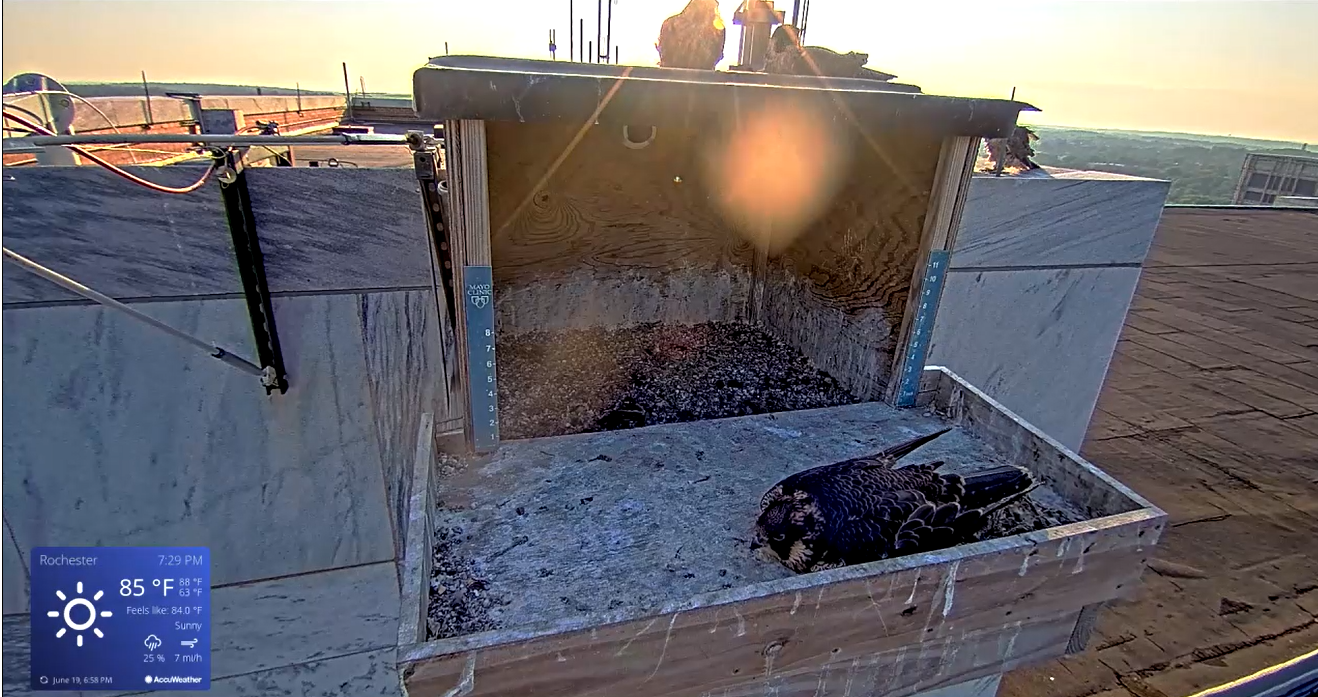
Returning Home!
June 19
Horus, Genesis, Aero, and Piper returned to the nest box at the same time tonight, which was a first since Genesis fledged on June 5th. Over the past 14 days, the four fledglings were often found in a variety of locations, most often perched or in flight where their identity could not be confirmed, and never more than three fledglings at any one time. However, at 8:09 p.m. CT tonight, all four fledglings showed up at their natal nest box at the same time. As mentioned before, fledging is the most difficult time in a young falcon's life, so it was a nice relief to see all of them together. Observations will continue through mid-July, to document their behavior and ability to gain enough skill to become fully independent young peregrine falcons.
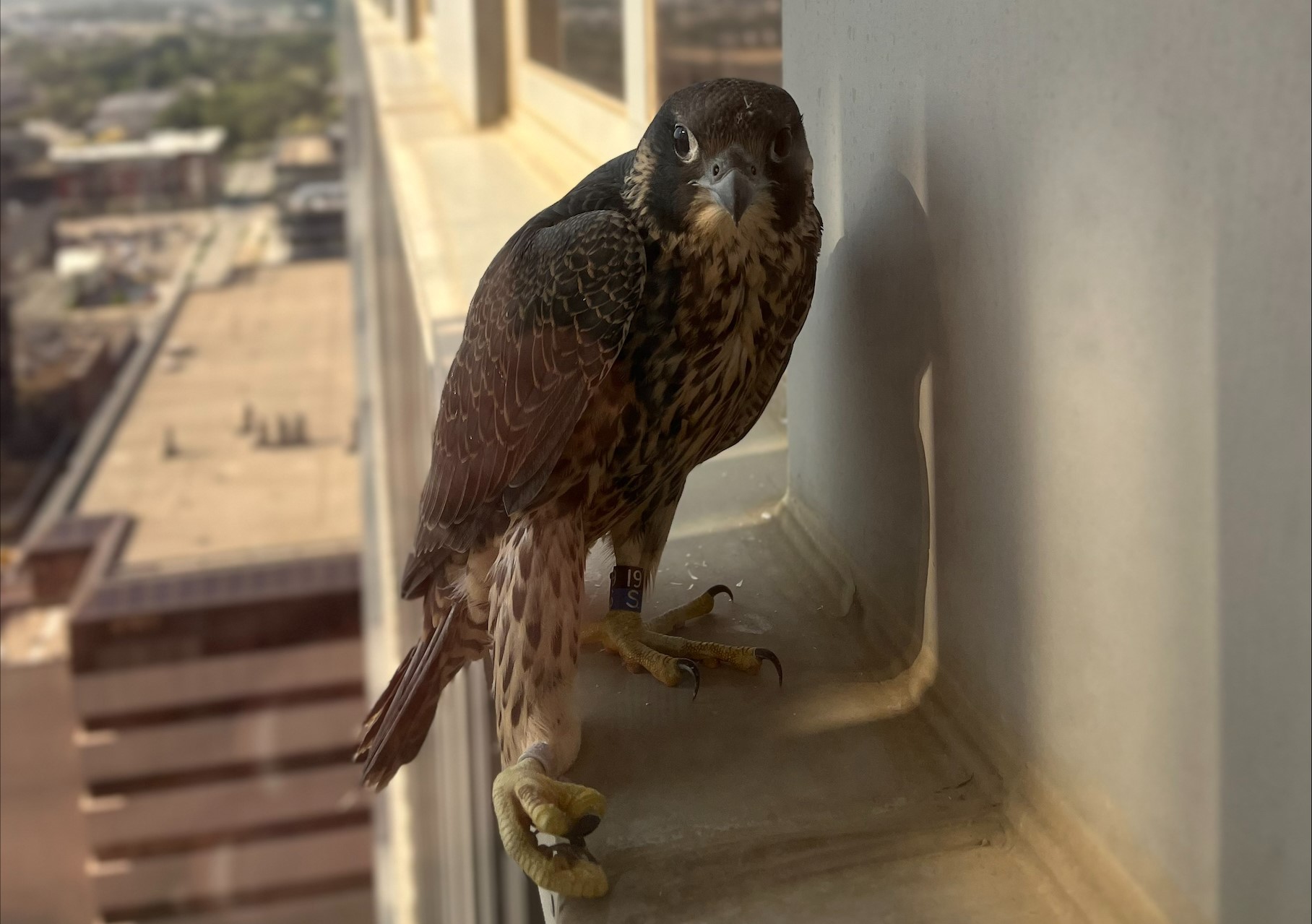
Next Stage in Life: Fledging
June 9
Horus, Genesis, Aero, and Piper have now all taken their maiden flight, although not the most graceful by some standards. Peregrines typically fledge between 38 and 42 days of age, sometimes up to 44 days old and this year was no exception. The fledglings may or may not return to the box with any consistency once they fledge, but often, at least one bird is in or near the box for at least a week or so after fledging.
There are many variables involved with fledging and sometimes it is just luck of nature: it can be a chosen choice to fly or an accidental nudge by a sibling. Sometimes it is a strong incentive for food, which means a deadly mistake if a nestling is only 30 days old. Be aware that flight isn't an instant skill or knowledge but rather something mastered through observation and practice. The longer the nestlings stay in the eyrie (nest), the higher the chance of success for flight. A few days' time can make a significant difference in feather growth, and the more fully developed the feathers are, the better control the fledgling has during flight. Obviously, the nestling doesn't cognitively think all of these things out, and things happen when they happen.
The challenge of fledging includes inexperience in coordinating their flight in strong winds, recognizing the dangers of glass windows and walls, and getting off the ground if they land there. Mayo Facilities staff are a critical part of recovering grounded falcon fledglings and coordinating their return. The entire Mayo Clinic Peregrine Falcon team will continue to monitor the fledglings through July, before they become fully independent and leave their natal territory in late summer.

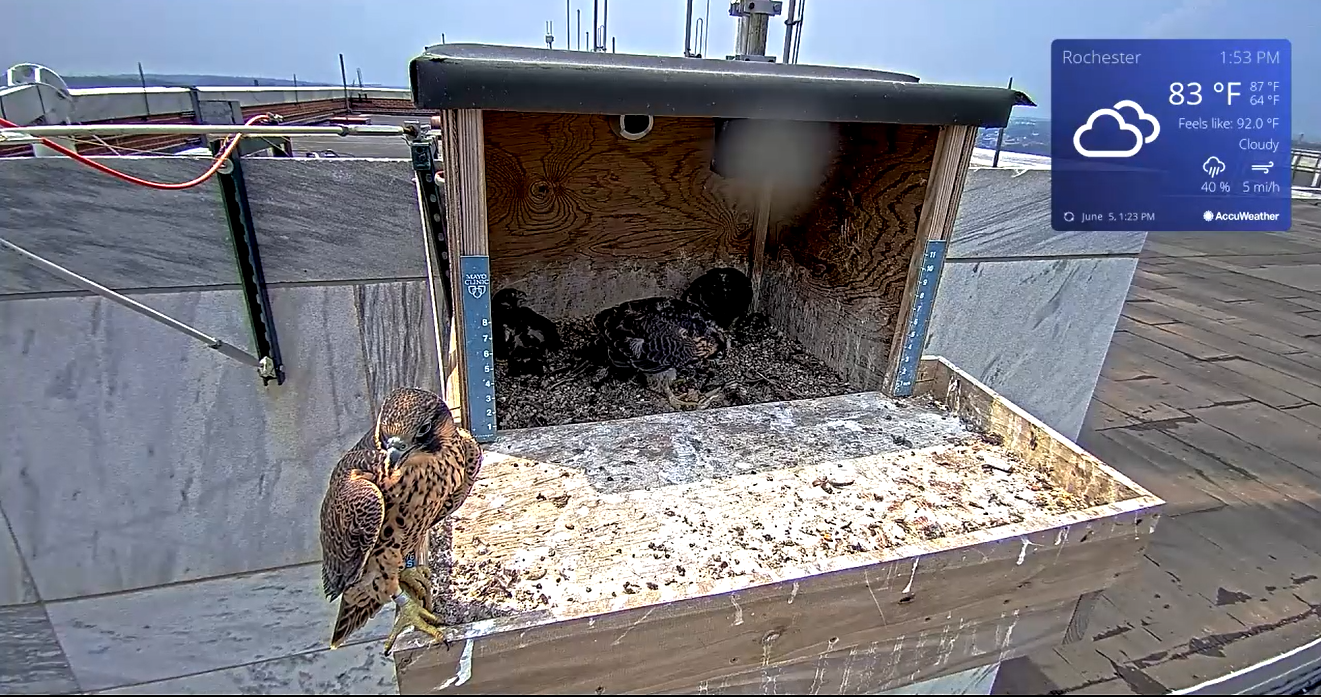
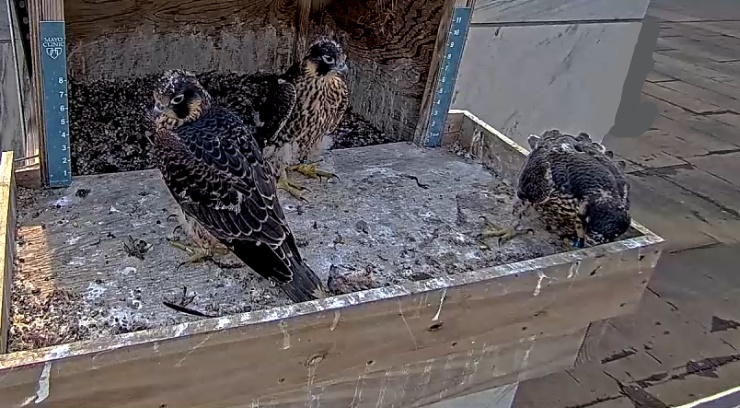
June 6

June 5
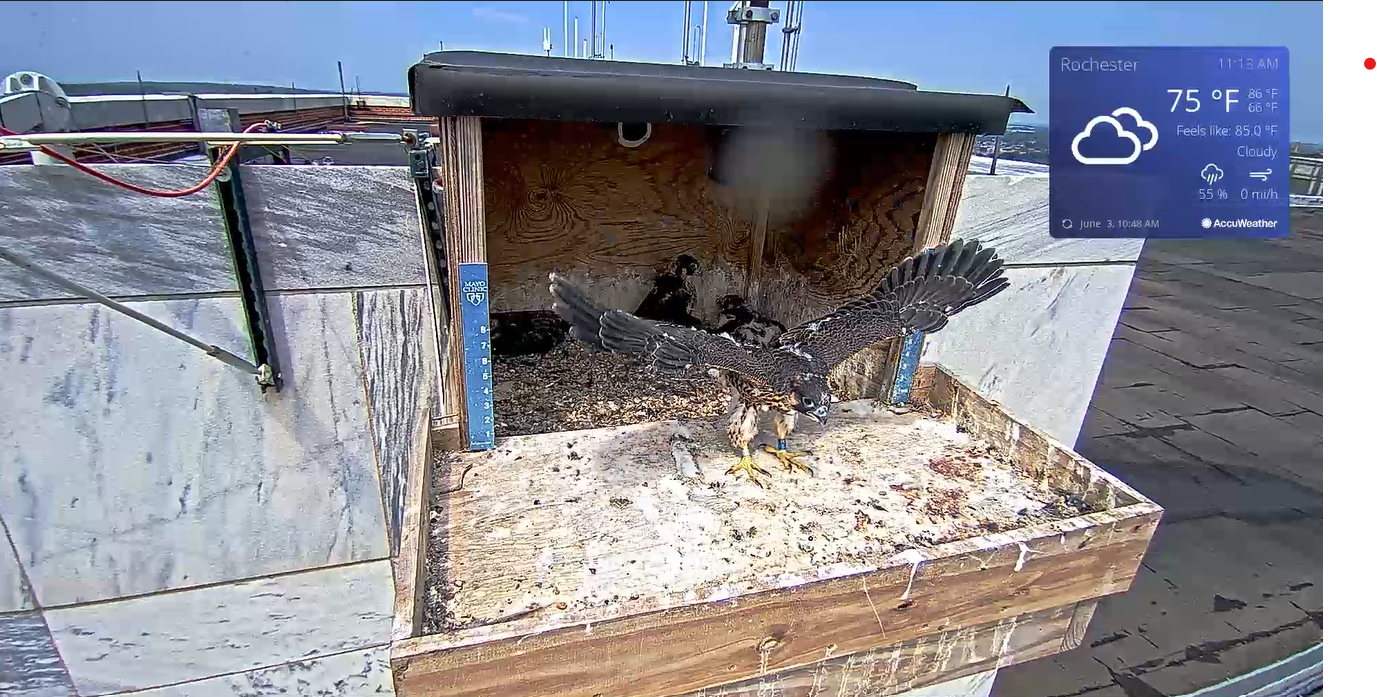
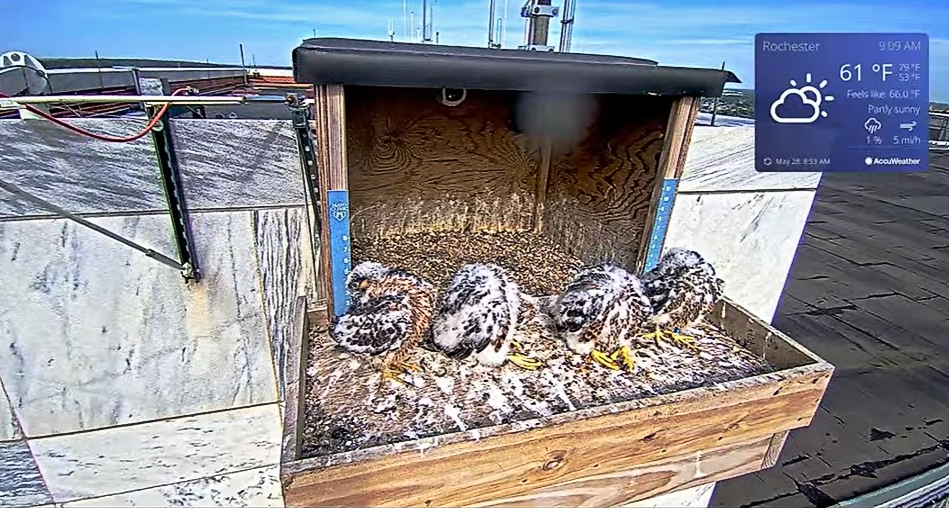
If you've been watching the Rochester falcon family since hatch, you've noticed that the nestlings have grown from weak, helpless, wobbly-head fluff balls into something that is closely resembling a peregrine falcon. It seems like they're changing right before our eyes, with the male peregrines, Horus and Genesis, being 50% or more brown in color, while Aero and Piper are still mostly white fluff with less brown body covert coverings.
All of these new feathers require a lot of preening to keep them healthy and strong for future flight and insulation. This also helps keep insects and parasites under control. Since there are so many feathers growing in all at one time, the nestlings are spending nearly 40% of their day or more preening. Once they have all of their feathers completely grown in, that time spent drops considerably to maybe 10% of their day or less.
being conducted under a federally authorized Bird
Banding Permit issued by the U.S. Geological
Survey

My, How Time Flies!
May 18, 2023
It seems like just yesterday that the first two eggs hatched in the early hours of Saturday, April 29th, 2023, in the falcon nest box in downtown Rochester. Over the past 19 days, the chicks have increased in size by nearly 20 times, are more aware of their surroundings, preening their own feathers, waddling around the gravel, and eating bones and feathers instead of just muscle tissue. Their eyes are wide open instead of small slits that couldn't focus on their surroundings, their flight feathers are erupting from the feather sheaths, and they no longer need any help from their parents to stay warm. In another three weeks' time, they will be close to taking their first flight and starting on another adventure in the life of a peregrine falcon.
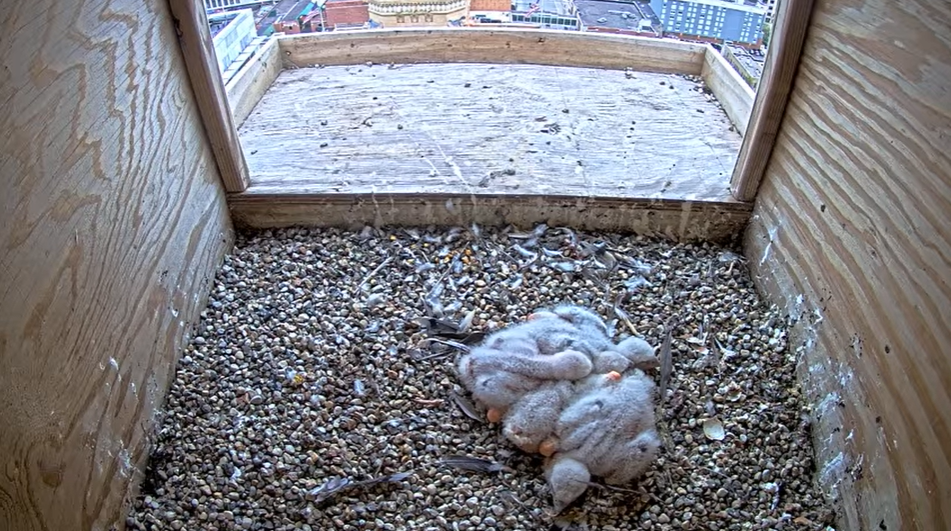
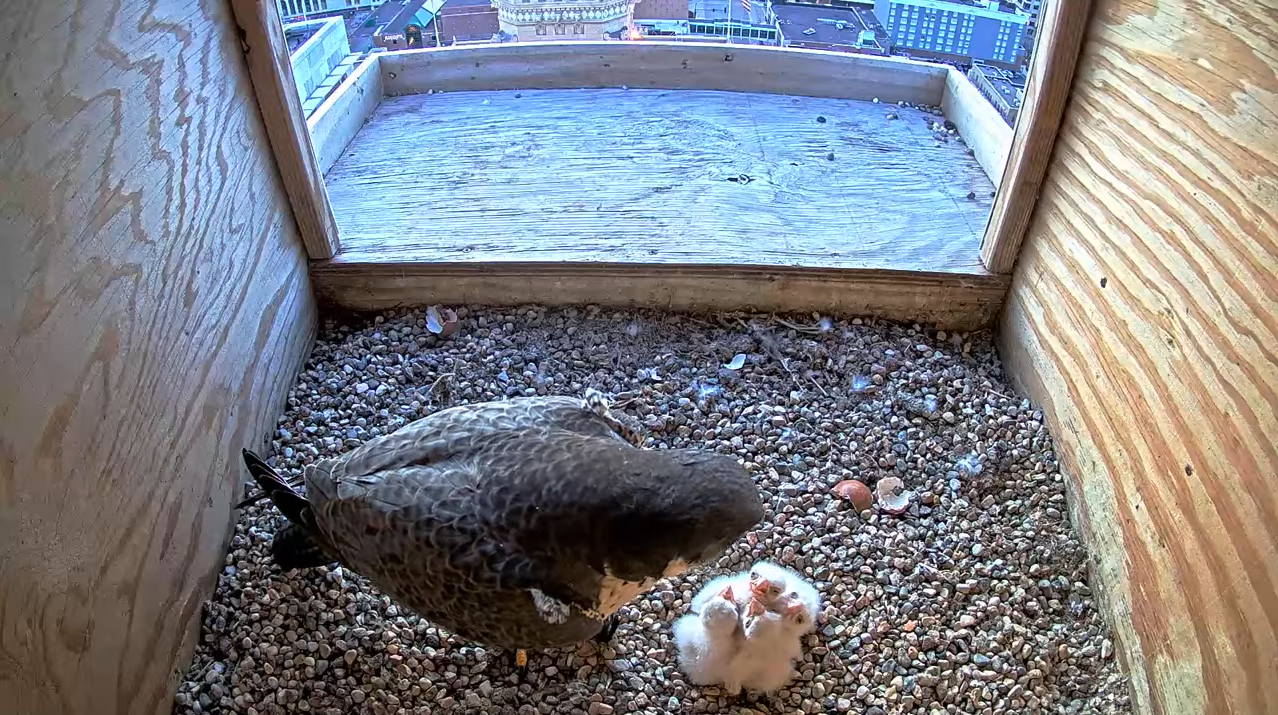
Click on the link to watch feeding time for the four peregrine falcon chicks, bright and early this morning!
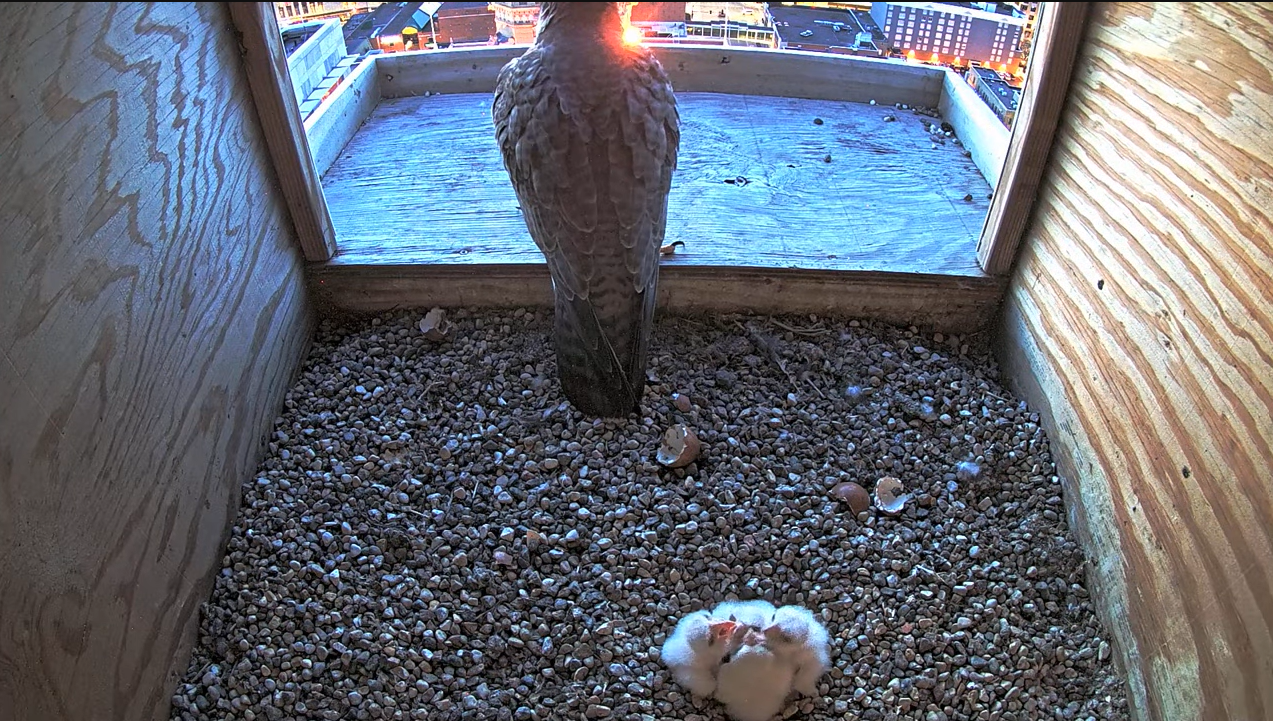
The fourth chick hatched early this morning, bringing our falcon family to six for the next few months. In these first days after hatch, Orton will be the primary food provider and Hattie will do the majority of the feeding. Of course, it's still important for them to protect the chicks from the elements, and they cover them almost all the time except for during feeding.
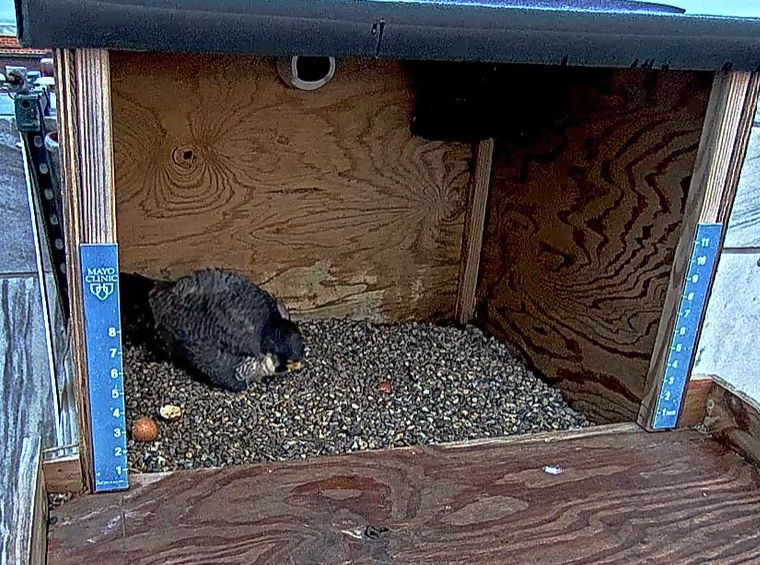
April 29
We observed the pip (small hole in the shell) of one egg on April 28 at 7:15 p.m. although we had been hearing chick vocalizations a few hours prior. Things proceeded according to schedule and today we confirmed hatch of two chicks at around 4:30 a.m. By 10:13 a.m. we confirmed that an additional chick had also hatched, bringing our total to three so far.
The adults are doing a great job caring for the new nestlings. Orton is bringing in plenty of fresh food, although Hattie is the parent doing all of the feeding, which happens about every two hours or so.
The adults will keep the chick and eggs covered as much as possible but you may notice a bit of white among the remaining eggs when the adults shift position.

In these final days before hatch, you might observe the adults shuffling over the eggs more frequently, repositioning their bodies, and even rising up a little over the eggs instead of sitting low and settled over them. You may even hear very quiet vocalizations in the nest box as the adults communicate to the embryos and vice versa. Notice that now Hattie is more reluctant to leave the nest box when Orton flies in for his turn on the eggs.

March 29
From her vantage point on the roof of the Plummer Building in downtown Rochester, Jackie Fallon explains where you might locate Mayo's peregrine falcons. Enjoy this brief video to learn more.
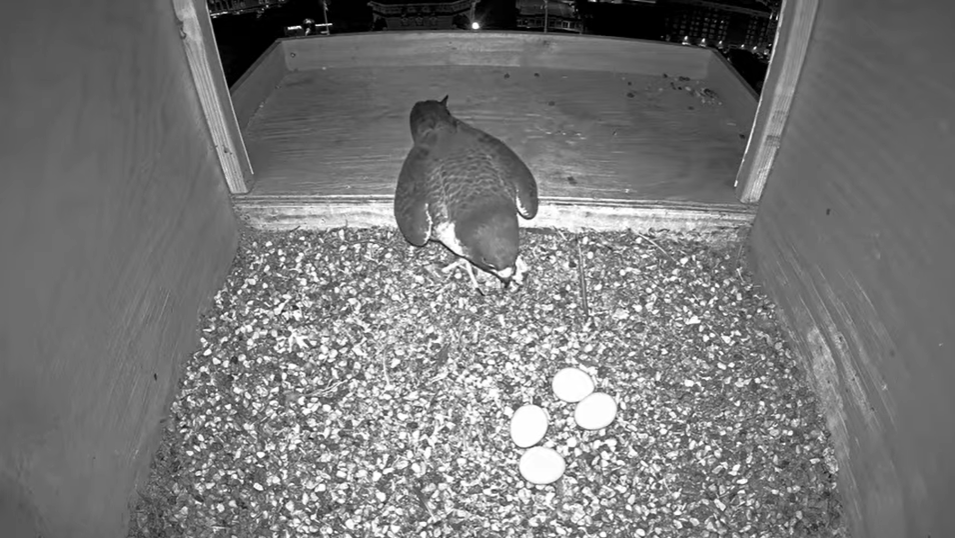
March 27
Early this morning, Hattie laid egg number four in the nest box in downtown Rochester. Incubation has begun and there are only a few questions left to ask: 1-Will a fifth egg arrive? When will the eggs hatch? These questions are related to each other and we cannot answer the second question until we know the answer to the fifth. By Thursday, we will know for sure the total number of eggs laid for the 2023 season.
Happy Monday everyone!
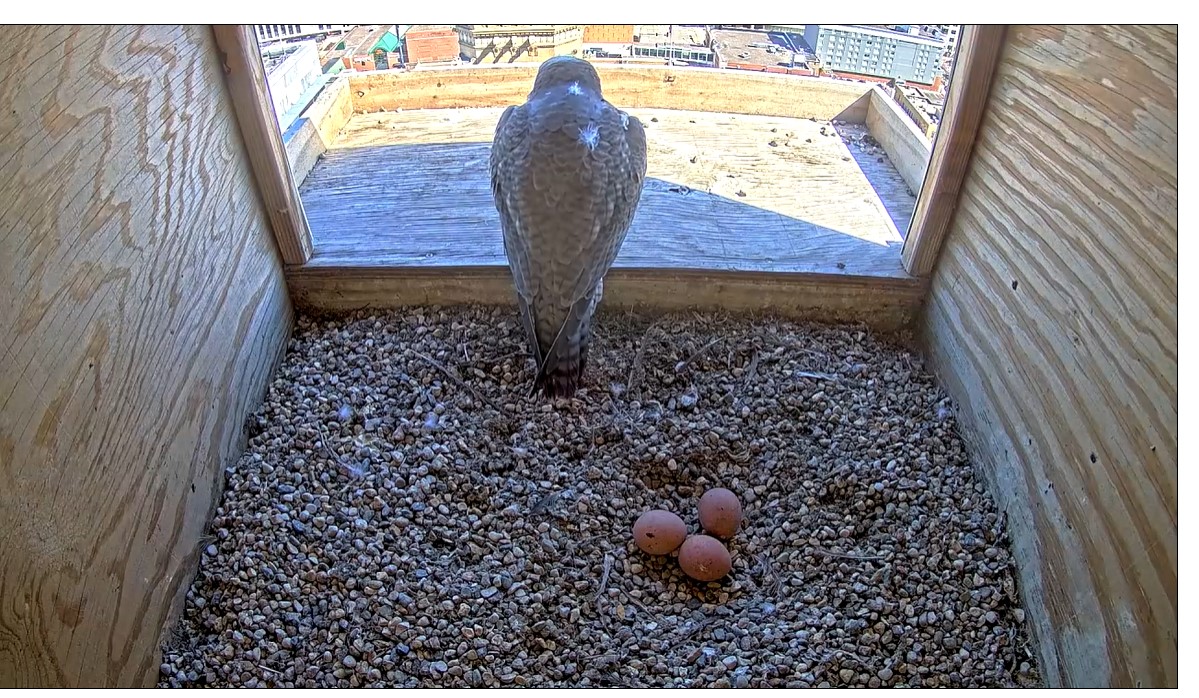
March 24
Another egg was laid earlier this afternoon, bringing the total clutch size to three. In this photo, Orton is keeping watch against potential intruders such as any other raptors or humans.
Since the third egg has arrived, you will start to notice that either Hattie or Orton will be resting on the eggs or incubating them nearly the entire time you check the web camera. There is always the possibility that Hattie could lay two more eggs, bringing the entire clutch size to five, which would mean that incubation will not begin until the fourth egg arrives. This should happen by Monday, March 27th. Nature, and Hattie, are the only ones who know the true answer. As we have more information, we will be sure to update you here, as well as on the new Mayo Clinic Peregrine Falcon Program Facebook Page.

March 23
In this feature, Jackie Fallon, naturalist with the Mayo Clinic Peregrine Falcon Program, explains the mating behavior of peregrine falcons. Watch this video to learn more.
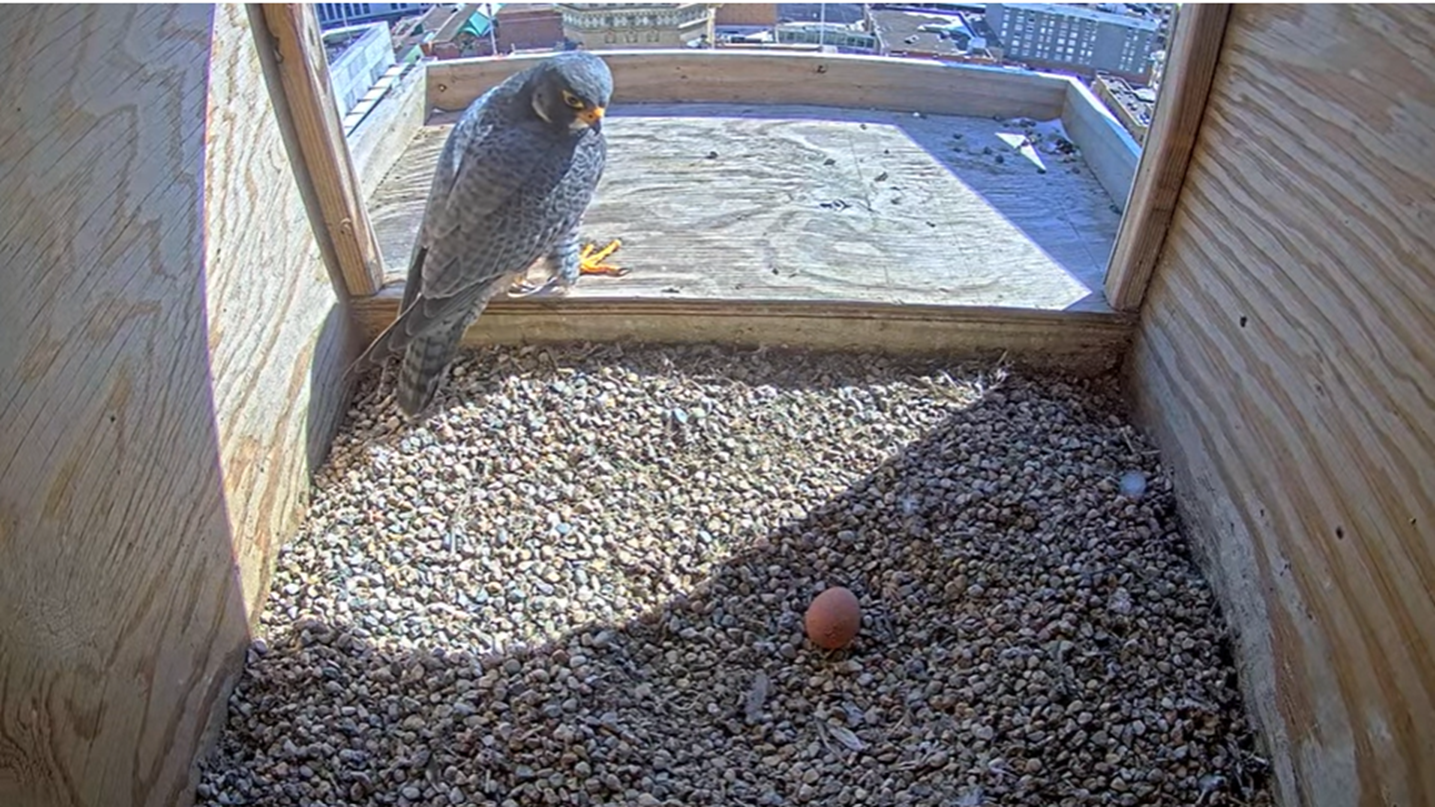
March 20
We can officially announce the start date of the 2023 falcon nesting season in Rochester, MN!! The first ![]() arrived yesterday morning, and now we wait and see how many other eggs will join this first one.
arrived yesterday morning, and now we wait and see how many other eggs will join this first one.
We have no idea how many eggs Hattie will lay in this year's clutch (group of eggs). The typical clutch size is three to four eggs, but the total number could range from one to five. Occasionally, a female will lay more than five eggs, but we have never experienced a brood (group of chicks) of chicks larger than five in the Upper Midwest. If Hattie lays more than this first egg, there is typically 48-60 hours between each egg, but the interval may also be greater than 72 hours in rare cases.
Hattie and Orton will not begin incubating the first egg, or any future eggs, until the second to last egg of the clutch is laid. This ensures that any fertile eggs will hatch within a few days of each other. The parents may sit on the egg(s) during cold weather, when temperatures are below freezing, but this is not true incubation. Both adult falcons will incubate the eggs, but the majority of incubation duties is done by the female peregrine. You may even notice a bare patch of feathers on Hattie or Orton's belly. This is called the brood patch, which allows the peregrine to better incubate the eggs and keep them at a constant temperature.
We hope this answers your questions about the eggs, and Hattie and Orton's behavior.

March 16
As the 2023 peregrine falcon season ramps up, Jackie Fallon is recording brief videos we're calling "Jackie's Chat" to share more about her work as a naturalist and peregrine falcon expert. Watch this video to learn how Jackie conducts her regular field observations.

March 8
So far, things are progressing well with our peregrine falcon pair, Hattie and Orton. We’ve observed several encounters between Hattie and other adult female peregrines, and a single chase by Orton toward an adult male, but thankfully the encounters were short and didn’t result in any significant injuries.
Peregrine courtship involves many things, such as perching next to one another, performing AMAZING aerial displays of flight, making a scrape at the eyrie (nest), and food exchanges with each other. The pair will also bow towards each other, where they often vocalize with an eechip sound, which seems to function as appeasement. They will also be observed by preening each other and nibbling at the other bird’s toes or bill. Things continue to escalate as the courtship bond increases, when you see cooperative hunting and food transfers, with the male presenting food to the female. All of this behavior is essential for mating to occur, which happens multiple times during the day but is only a few seconds in duration. Mating occurs several weeks before the first egg is laid and occasionally may be observed after a full clutch is complete.
Right now, we are just waiting anxiously for the first egg to arrive, which should happen by the first week in April. My guess is that the first egg will arrive around March 23rd or so, but that is just a guess - only Hattie and Orton know the true date, and they don’t seem to be sharing with us. Stay tuned, and please don’t hesitate to send any questions to us at peregrines@mayo.edu.

February 7
Welcome everyone! We are happy to let you know we went LIVE this morning with the nest box camera and are ready to welcome a new brood of peregrine chicks to Mayo Clinic, Rochester. The nest box was cleaned out last fall, with a little sprucing up in January, and all of the camera equipment was tested and put in place for the upcoming season. It’s important to do this during the “off-season”, to minimize any disturbance to the falcons and possibly cause them to find an alternative location to nest.
Another thing we do during the winter is to do as much of the annual facility maintenance on the clinic building rooftops before the falcons start their courtship. This minimizes disturbance to the falcons but also minimizes a strong defensive response by the birds toward Mayo Clinic staff and the field team. Safety for both birds and humans is a big concern for us, and why we do all of our observations remotely or from at least 500 feet away.
As in previous years, Hattie and Orton remained on territory throughout the winter and survived our ever-changing Minnesota climate. It is a misconception that all peregrines migrate or that they migrate together. Hattie and Orton are entering their eighth nesting season together, and both birds have remained in the Rochester area the entire year. Staying on territory may have its advantages, but there are also disadvantages in some northern climates with temperature extremes and possible frostbite risks.
We also want to mention that we have started a new Mayo Clinic Peregrine Falcon Program Facebook page, where you can find additional information about the peregrines that choose to nest at the Rochester downtown clinic. Here’s to a GREAT 2023 season, hopefully, filled with eggs and future generations of falcons in Minnesota.
